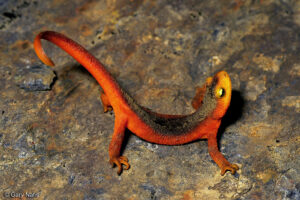Sierra Newts – Amorous Amphibians

Throughout most of the year, brilliantly colored Sierra newts (Taricha sierrae) lives on land, hunting and eating insects, earthworms, and slugs and hiding from any potential predators in the moist soil beneath rocks and logs. In the winter and spring, however, these members of the family Salamandridae become aquatic, returning to the pond or stream where they were born in search of a good time.
Mating season for Sierra newts typically extends from December to early May. During this time, most adult newts will return to the pool in which they hatched in search of a mate. Once in the water, a newt’s skin becomes smoother, and their tails become more rudder-like. Male Sierra newts also develop thick pads on their feet, allowing them to hold onto females while mating – not an easy task when competing with other males while underwater.

By the time female Sierra newts arrive at their mating grounds, the males have already been there for weeks, staking their claim and sizing up the competition. With the arrival of the females, these amorous amphibians cluster into balls, with multiple males each wrestling for the attention and affection of a single female. Once a male has fought off his competitors and emerged victorious, he swims away with his mate and leaves the remaining males to search for another available female. According to the National Park Service, “after a male successfully grasps a female and swims away with her, he will deposit a spermatophore, which she carries to a suitable spot to fertilize and lay her eggs. Each spherical egg contains between 7 and 30 eggs and is attached to submerged vegetation or other underwater objects”.

All this activity seems like it might draw a lot of attention and curiosity and make the mating Sierra newts vulnerable to predators. While this may be the case, the newts possess an evolutionary tool that helps keep them safe. The bright orange-red color of their underside acts as a signal communicating to other animals that they are poisonous!
The skin of Sierra newts contains glands that secrete tetrodotoxin (a potent neurotoxin significantly more powerful than cyanide). This is the same type of toxin found in pufferfish, blue-ringed octopuses, and harlequin frogs and causes seizures that paralyze the heart and lungs. If a newt feels threatened, it will arch its back and display the bright color under its chin and tail. This is usually enough to convince most predators that the newt is not a smart choice for a meal.

There is, however, one predator that will not be deterred by either the Sierra newt’s defensive signal or the toxin they secrete. Garter snakes have preyed upon newts for so long that they have actually evolved to be resistant to the toxin. The relationship between Sierra newts and garter snakes is a fascinating example of coevolution. Locked in an evolutionary arms race, the newts continue to develop progressively more potent toxins and the snakes respond by building an even better resistance to the toxin.
Over time, this pattern has continued to the point that the tetrodotoxin the newt produces is “more powerful than it needs to be to subdue any other possible predator, but not quite powerful enough to drive away the (garter) snakes” (Jason Goldman, Earth Touch News). In fact, when a garter snake feeds on Sierra newts, they can retain the newt’s toxin in their liver for weeks, which makes the snake not only venomous, but poisonous as well.
Unlike garter snakes, humans have not built up a resistance to the tetrodotoxin produced by Sierra newts. The toxin can be absorbed though mucus membranes and open cuts and wounds, so if you see one of these adorable amphibians when out exploring the Yuba River watershed, remember – look, but don’t touch!
To learn more about Sierra newts, watch ‘Water Lovin Nudies‘, which was featured at the 2014 Wild & Scenic Film Festival:
Did you enjoy this post?
Get new SYRCL articles delivered to your inbox by subscribing to our ENews.




